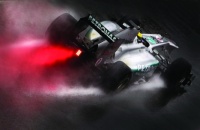
Mention the start of the F1 season this weekend, and you’re likely to get one of two responses. Either your companion’s eyes will light up, and you won’t get them off the subject, or you’ll get an indifferent shrug, and the worn comment about ‘cars going around in procession.’
Both responses are just as valid. For instance, after the initial race in Bahrain last season, former world champion, Jenson Button, said that he thought F1 was beginning to lack drama. The ban on refueling and the new tyre regulations were causing drivers to become more cautious about overtaking, and the opening race was declared to be ‘dull’.
As it turned out, the 2010 season was one of the most exciting yet. It had all the drama you could expect from F1, including driver rivalries, spectacular mechanical errors and a nail biting finale. But the season took a while to get going, and for many, the regulations certainly didn’t help.
This year, the Federation Internationale de L’Automobile (FIA) are determined not to make the same mistake. They have introduced a raft of new technical rules designed to increase speed and promote overtaking. Judging from the pre-season testing, even the big names on the grid have had a tough time introducing some of the components.
The first of these is the Kinetic Energy Recovery System (KERS), making a comeback from its controversial debut in 2009. KERS stores energy that is otherwise wasted during braking and uses it to boost acceleration coming out of corners and overtaking. Drivers have access to fixed quantities of this power through a boost button on their steering wheel.
One of the challenges engineers have faced this year is packaging the KERS battery within the car. Fuel tanks are larger now that refueling is banned and so space is even more so at a premium. The FIA has attempted to counter this by increasing the minimum car weight by 20kg to 640kg.
Alongside KERS, adjustable rear wings have been introduced to boost speed. Also known as the Drag Recovery System (DRS), the rear wings can be altered electronically by the driver. DRS can be used at any time during practice and qualifying, but in the race, drivers can only use it if they are less than one second behind another car and at certain points on the circuit.
Neither of these systems are compulsory, however, it is thought that all teams will use DRS and only three teams- Hispania Racing, TeamLotus and Marussia Virgin Racing- won’t be using KERS. Red Bull’s Sebastian Vettel takes a look at both these systems in the animated video below:
Video:
F12
If dealing with all the rules associated with KERS and DRS isn’t complicated enough, drivers will also have to contend with the introduction of Pirelli tyres, which wear out much faster than their Bridgestone predecessors. This will mean that pit stop strategy will be all important, as will the regulation of speed.
‘I believe that we can expect a very exciting season in 2011,’ said Mercedes team principal, Ross Brawn. ‘The strategic battle is going to be fascinating with the Pirelli tyres, combined with the new adjustable rear wing and the return of KERS, increasing the challenges for the teams and drivers, and hopefully providing lots of track action for the fans.’
The Australian Grand Prix will take place this Sunday at 7am. It is billed to be one of the most atmospheric races of the season, with a street circuit that uses the public roads surrounding a man-made lake. Let’s hope with the new regulations, the opening race will turn out to be more like a game of high speed chess than a dull procession.




Nanogenerator consumes CO2 to generate electricity
Nice to see my my views being backed up by no less a figure than Sabine Hossenfelder https://youtu.be/QoJzs4fA4fo